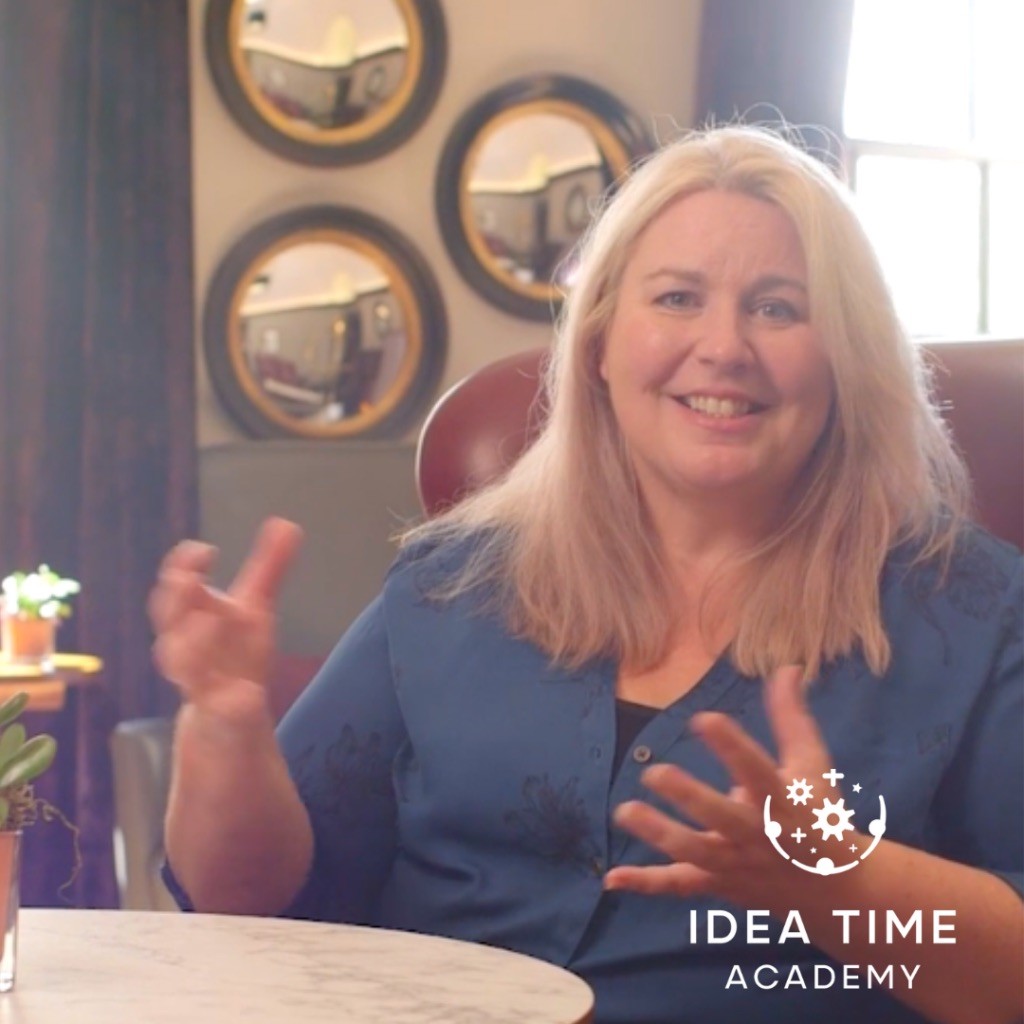Posted in Blog, Create, Design Thinking, Lead Your Team by Jo North
In this article, I share why stories are so important, show you how you can use a story technique to plan your agenda, and then outline ten different story-based facilitation activities that you can do.
Before we start, download my free toolkit from the Facilitation Toolkits section of my Content Studio here.
Are you sitting comfortably? Then I’ll begin!
Stories are important to humans
Stories are important to humans. Throughout time we have always shared stories. Stories have been important for community, for learning, for passing on knowledge through generations, for bringing us together.
Stories also help us expand our creativity, use our imagination and play with possibilities.
And through story we can put ourselves in the shoes of someone else – a customer, colleague, stakeholder – to help us see different perspectives when we are innovating, or working on a different strategy for the business.
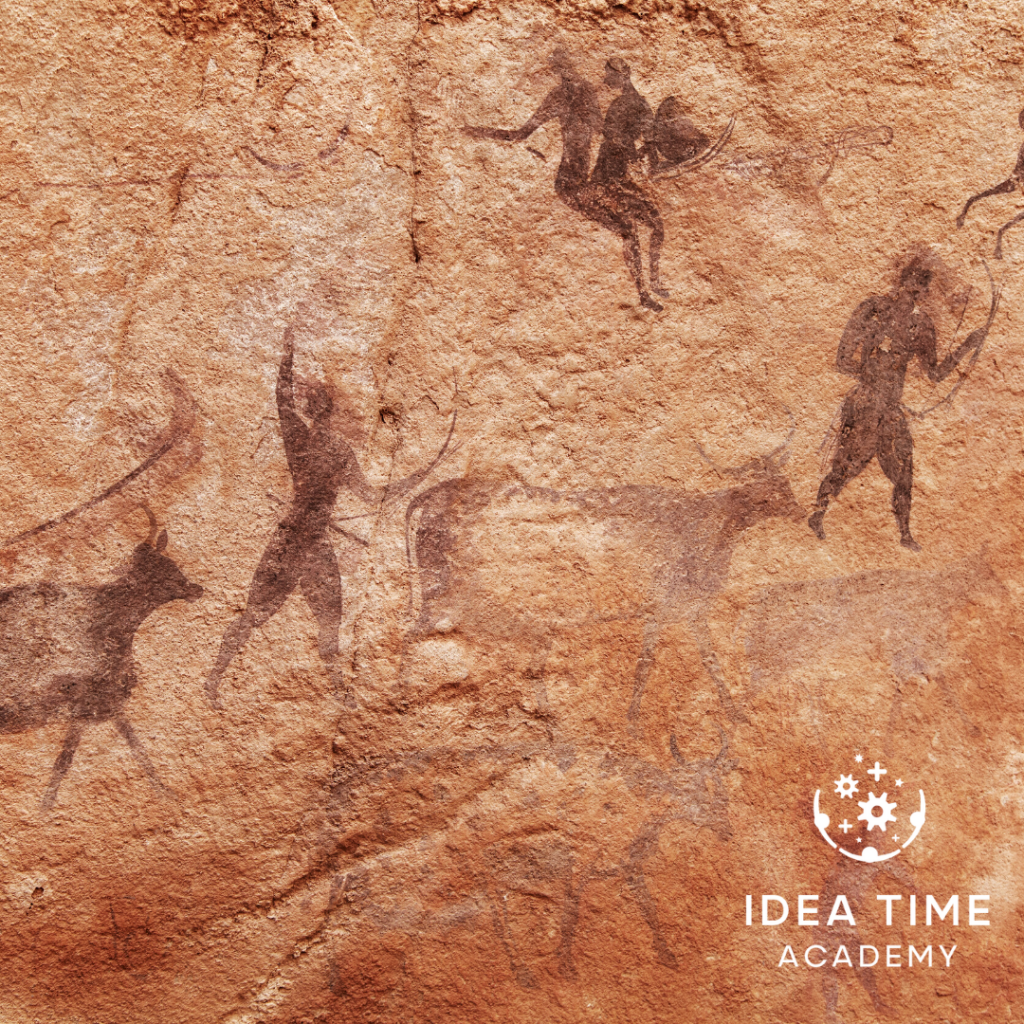
A story includes words AND pictures
By story I don’t just mean words, I also mean pictures. It’s estimated that we process images 60,000 times faster than we do text. 90% of the information we take in is visual, so pictures are important. When you’re thinking about using story techniques, think words and pictures together to create that story.
The hero’s journey (Joseph Campbell)
Have you heard of the hero’s journey concept by Joseph Campbell? A formula underpins all great story telling that we can trace back to the pre-literary age. The formula is present in religious literature, ancient mythology, great medieval oral narratives, Hollywood blockbusters, reality tv, gripping thriller novels and more…
The hero’s journey begins with a call to adventure, and there’s usually an external influence – even some sort of supernatural aid, something in the universe helping.
The hero has to go over a threshold to start their transformation. They go out of their comfort zone and into a world or situation that they aren’t familiar with. That world is full of challenges, it is full of temptations, and difficulty. There is usually something really significant that the hero has to overcome. They overcome that, go through a transformation, and then go back into the world they were in before. Having had the gift of this transformation they use this progression to move forward.
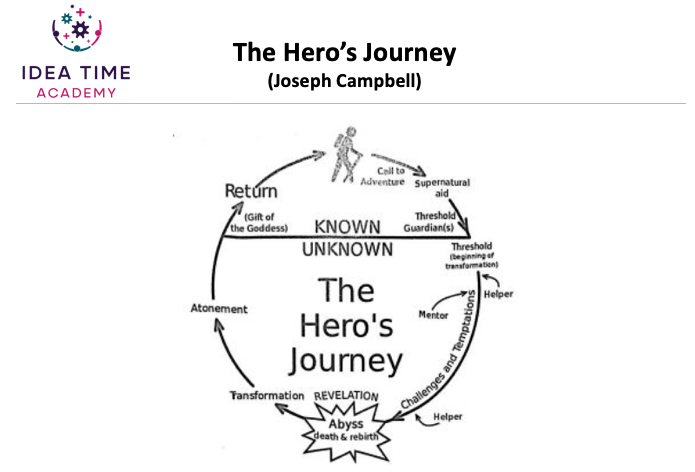
The hero’s journey – an outline agenda for your workshop
You can actually use the hero’s journey when you are planning your workshop agenda.
When people come into the room or join your session remotely, often their heads are in their usual day job. You agree the objectives for the day, and set in train a call to action. Your activities encourage ideas and collaboration. People get some creative sparks flying – and usually there’s also some tough stuff that they really have to think about and grapple with. But they break through, they get some great solutions and take those ideas back into the day job.

Hopefully you can see how you could use the hero’s journey concept to plan your agenda. As well as getting your target outcomes and achieving some breakthrough thinking, your delegates will have a really good day because they will experience the positive anticipation of the day, followed by the challenge and the reward of getting through to the other side and coming up with some great solutions.
Essentially it is that call to action, rallying round a cause that is at the heart of your delegates’ ‘journey’. You all work on it together – as the facilitator with a toolkit of activities, insight and resources, you’re the external influence that guides and supports the innovation journey, the assimilation of learning, the change or transformation.
Mix it up
When you use story as your foundation, you don’t have to use story activities all day – in fact, for most situations, please don’t! Too much of the same isn’t a great storyline!
Select some techniques that you can use at different points in your workshop, and mix them in with other types of techniques. Use your judgement, put these activities together in different ways. Be creative and you will get a really great result.
All the activities that I am going to share with you here are tried and tested multiple times with many different delegates in a wide variety of scenarios, and they work really well.

10 Story techniques for facilitators
Story technique 1: Storyboarding
Ask delegates to create a storyboard for their selected challenge as follows: 1. Draw the current position in the first box.
2. Draw the ideal / target position in the last box.
3. Now fill in the boxes in between with drawings of how you will get from the current to the ideal.
4. Capture key steps in words under each drawing
This is can be a useful visual technique that helps to create a clear image of the goal and achievable steps towards it, overcoming obstacles on the way.
Make sure that delegates have fun drawing as a team – it doesn’t have to be a great piece of art, that’s part of the enjoyment!
If you want to look at some fantastic examples of storyboard, have a look at Pixar and see some great examples of how they actually use storyboarding for their animations.
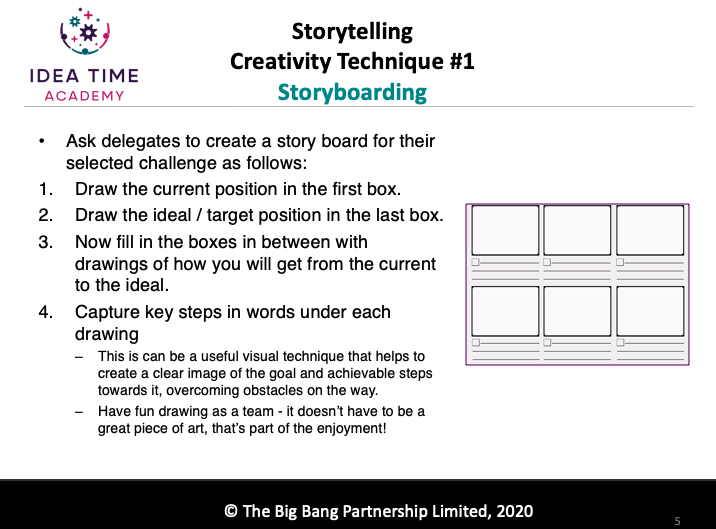
Story technique 2: Story cubes
Story cubes are small dice, and they have got pictures on each side. You can get different sets, and they are around $5 or $6. Ask delegates to roll their story cubes and create stories based on the pictures that they roll.
I have got a number of variations on how you can use these.
I have no association with Rory and his story cubes, but they are fabulous. They’re really great for getting people talking and thinking differently. People also like rolling the dice and being interactive
Here are just a few ideas of things that you can do with them.
- Warm up Each person throws three cubes, and they make up little stories up from those cubes. The stories are to be in connection with the workshop that you are running.
- Icebreaker Each person rolls just one cube, and when they introduce themselves to the group, have to link the picture they have rolled to something personal about themselves.
- Solution stories Delegates work in small teams and roll all six or nine of the dice. They construct a story based on all the pictures they have rolled as ideas for the theme of your workshop. For example, earlier this month I used this activity in a customer experience workshop. Delegates used the story cubes to create new customer experience stories. Some of them were really funny, but some of them were very insightful as well.
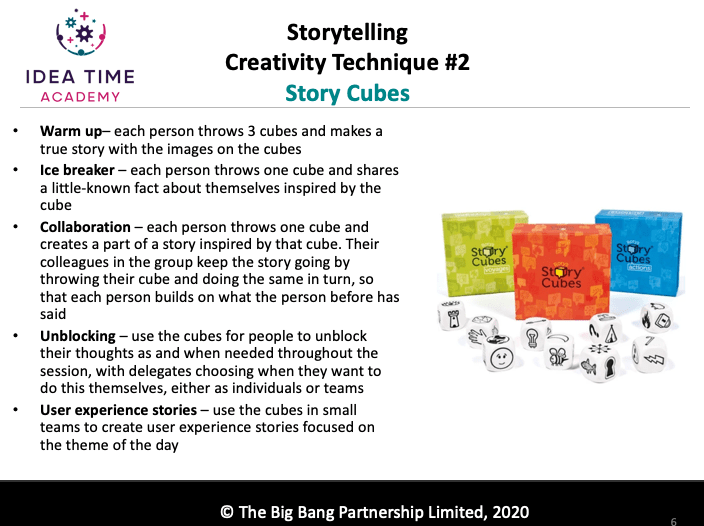
Story technique 3: The parable of the talents – reimagined
The third technique is what I call the ‘parable of the talents re-imagined’. Ask delegates to take ten-fifteen minutes to draw the story headlines of their life so far, and their hopes for the years ahead, on a flip chart paper, working on their own. That sounds like a big question for ten minutes, doesn’t it! But it does work. Delegates can start their story at whatever point they like – as far back or as recently as they want. Of course, they can share whatever they want, and don’t have to share things they don’t want to.
Individuals then use their flip chart as a visual aid to talk through their story for other delegates, highlighting things that have been significant, pivotal moments, things they are really proud of.
While each individual is sharing their story, a really lovely thing to do is for everybody listening to write three strengths, or three talents that they can hear, or see in their fellow delegate’s story, on individual sticky notes, Make sure they add the name of their colleague onto the sticky note.
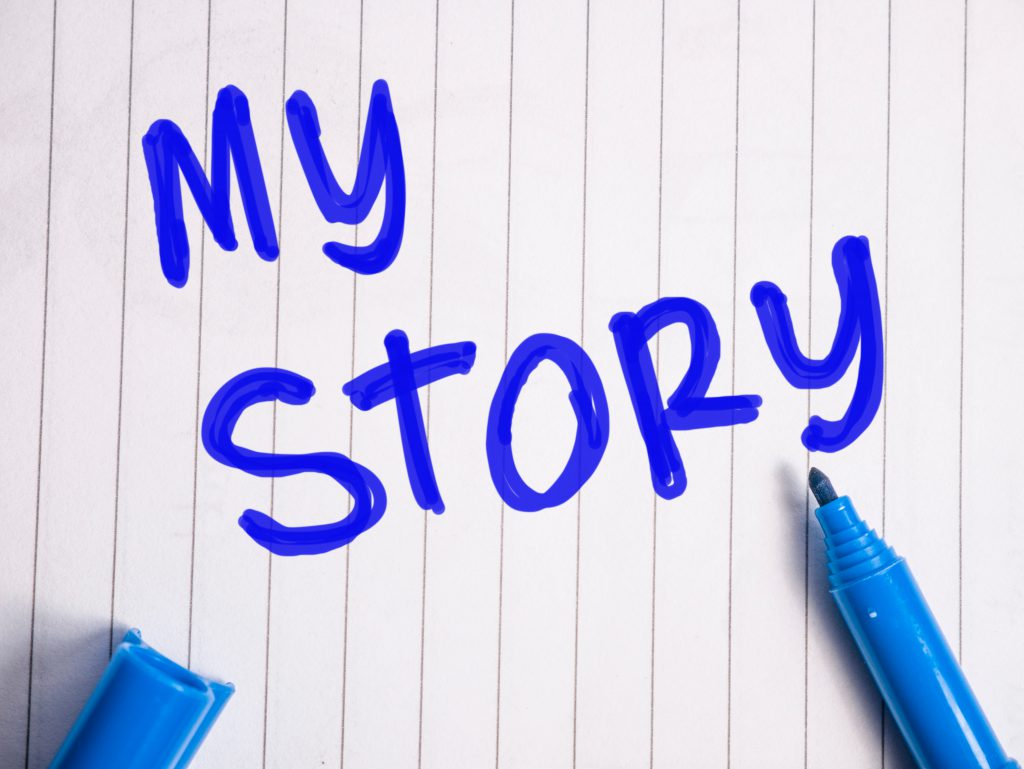
When everyone has shared their stories, create a talent matrix populated with everybody’s strengths and talents sticky notes.
If you’d like a specific step-by-step guide to this activity, and all the other activities in this blog, you can download my free toolkit from the Facilitation Toolkits section of my Content Studio here.
I have written the detail of all of these facilitation activities out for you, so all you have to do is click on that, download it, and have a look at it, and please do let me know how you get on with it!
Story technique 4: Experts’ or users’ stories.
In the Experts’ or Users’ Story technique, delegates in the audience ask between 1 and 3 subject matter expert (s) spontaneous questions relating to their experiences – told as stories – within the domain of experts’ focus areas.
The technique is an effective alternative listening to an expert give a standard presentation.

How to use it
- Seat experts / users at the front of the room, along with two empty chairs.
- Give a brief explanation of how the session will be run and ask the delegates to write down any insights they gain onto sticky notes for collection and display at the end of the session. Encourage delegates to ask about relevant issues, challenges and successes.
- Introduce each of the experts / users. Invite each of the experts / users to share their experiences of the matter in hand, talking delegates through the true story of what happened.
- Invite delegates who have questions with questions to take a seat on one of the two empty chairs available. Ask them to keep their questions concise.
- Once their question has been asked and answered, they should vacate the seat so that someone else with a question can sit down and ask it. Up to two delegates can sit at the front; one will be asking a question or listening to a reply, and the other is next in turn. Ask other delegates with questions to wait nearby so they can jump in quickly.
Story technique 5: A day in the life
This activity is especially suitable for events involving participants from different parts of the same project.
The creation of “day in the life” stories – each showing what delegates need to do their jobs – helps people to communicate visually and builds mutual understanding.
How to use it
- Ask delegates to create a visual storyboard that represents a typical day for them at work or relating to your specific collaboration project.
- Emphasise that drawing ability doesn’t matter – stick figures are fine.
- Ask each delegate to talk through their storyboard to other delegates, taking questions and observations as they go.
- Ask delegates to create a joint summary of any insights they have obtained from the activity as a whole.
This activity is also fantastic if you are doing business improvement workshops and want people to understand each other’s role in the process.

Story technique 6: Story of transformation
Use this technique towards the end of the workshop, when delegates have generated ideas, and selected and developed the most promising ones.
Ask delegates to tell the story of how the the customer or user experience will be transformed from what it is now to the new, improved version once the new ideas are in place. The customer or user should be the hero of the story. Delegates should have time to prepare their story and create posters to show the transformation, cutting and sticking from old magazines and newspapers; drawing; writing in key words.
Story technique 7: Create a tweetable
Story technique no. 7 is to simply create a tweetable. They don’t have to send it – just use the concept as a creative challenge. Again this is one you do at the end of the day. Delegates have done all their work, they have got their solution, and the challenge for them is to turn that solution into a story, which they can tweet in 280 characters or less. This really focuses the mind, and gets delegates to distil their ideas and thoughts down to the most important things so that they can communicate it quite simply.
It does take a bit of thinking to get it all drilled down into 280 characters, but can be good fun as well.
I have a global client, and they tweet all their new innovation ideas to several hundred customers around the world. Customers vote on whether or not it is a good idea, simply from that tweet. Einstein said you need to make things as simple as possible and no simpler, and I think a tweetable is a really nice way of thinking about how to express ideas.

Story technique 8: Three minute story
Use this technique towards the end of the workshop, when delegates have generated ideas, and selected and developed the most promising ones.
Ask delegates to prepare to tell a story showing how their ideas will be used in practice that takes fills at least 2 minutes and is no longer than 3 minutes.
This activity really focuses delegates on the core, most important elements of their ideas. It was inspired by the Three Minute Thesis (TMT) competition which challenges PhD students to educate and engage the audience with their research in just three minutes. The students are competing to communicate the impact of their research to an audience and judging panel.
Story technique 9: The end.
At the end of the day, ask delegates to work in small groups to visualise everything they have learned, everything that has stood out for them, all the memorable moments, and put that into a memorable story of the day that they present to their other colleagues in the room.
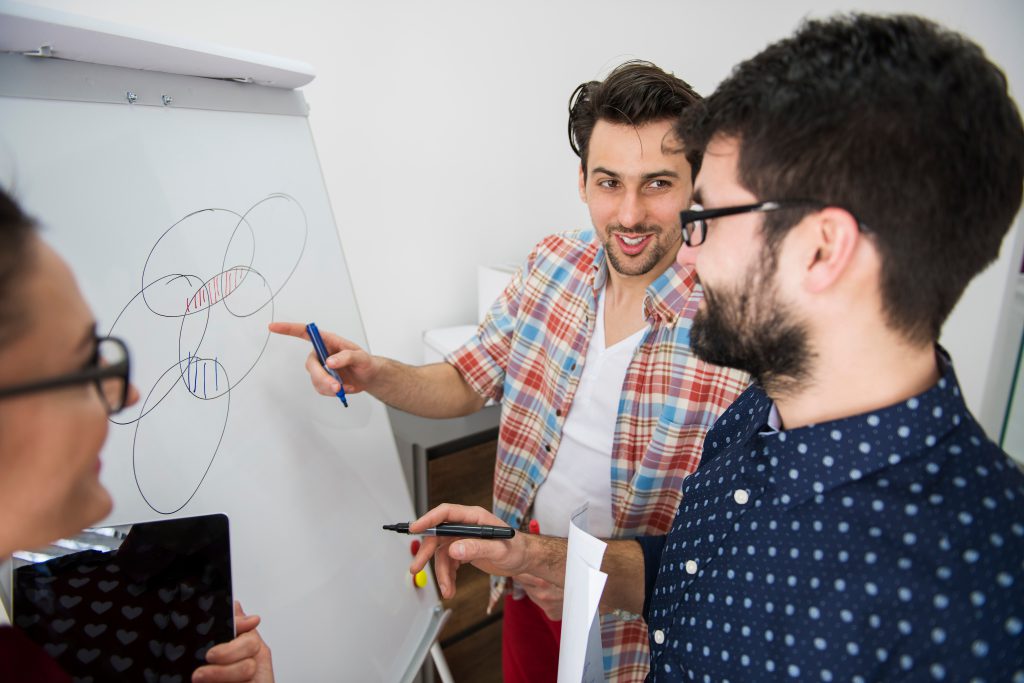
Story technique 10: Limericks
Technique no. 10 is to use limericks to create and share stories.
A limerick is a funny poem of five lines.
Here’s an example:
“There was a young lady of station
Lewis Carroll
‘I love man’ was her sole exclamation;
But when men cried: ‘You flatter,’
She replied, ‘Oh! no matter
Isle of Man is the true explanation.’”
You can use limericks in different ways in your workshops:
- As a warm up – split people into small teams and ask them to write and share a limerick that represents the team.
- As a fun energiser after lunch, or mid afternoon.
- As a way to get delegates thinking creatively about their challenge.
- As a means of expressing different ideas.
For a happily ever after…
If you haven’t done so yet, download my free toolkit from the Facilitation Toolkits section of my Content Studio here.
I’d really love to hear what you think, and how you get on with trying out some of these techniques.
If you’d like any help, please contact me direct using the contact form below and I will respond personally.
If you’ve enjoyed this and would like scores more of great facilitation activities like these, and would love to expand your creativity, confidence and impact as a facilitator, check out the Idea Time Academy here.
Thank you so much for joining me, I’ll see you next time.
